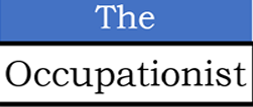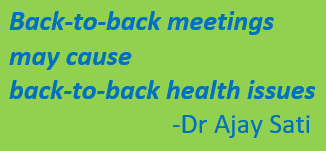Microsoft CEO Satya Nadella is known to tell employees to skip pointless meetings that waste their time.
Satya Nadella, during covid once remarked by citing brain studies about video meetings to highlight how draining they can be, saying, “Thirty minutes into your first video meeting in the morning, because of the concentration one needs to have in video, you are fatigued”.
These are real things, yet we all ignore them. We continue to go from one meeting into the other, without a break, and sometimes take pride in it to signify one’s busy state, not realizing that it is not helping anyone and, in the end, can be a cause for mental health issues, for oneself as well as to coworkers, including burnout. This is what research says.
The question to ask is: you may be comfortable in going from one meeting to the other, but are other coworkers ok with it?
In a 2019 survey involving 2000 people by organizational consultancy Korn Ferry, it was found that too many meetings are a distraction preventing 67% of professionals from making an impact.
And it is not that meeting gives us just a perception of anxiety. Initial research shows it is something real that our brains work differently if meetings are too many and without breaks.
An interesting research was conducted at Microsoft’s Human Factors Lab in 2021 where 14 people were asked to participate in video calls wearing an EEG (electroencephalogram) equipment that senses electrical activity in the brain. On a Monday, some were given four half-hour meetings without breaks, while others had similar meetings but with a 10-minute break for meditation. On the following Monday the two groups interchanged.
In the group that did not get any breaks, beta activity increased in the brain with each successive meeting, indicative of high stress levels. In fact, the researchers found that just the anticipation of the next meeting caused a spike in beta activity in between the two meeting.
The researchers also measured the frontal alpha asymmetry (it is the difference in right and left alpha wave activity over frontal region) which is indicative of mental engagement levels.
Those who took breaks showed positive frontal alpha asymmetry (FAS) suggestive of higher mental engagement during meeting, while those without breaks had negative FAS suggestive of being mentally withdrawn.
People might argue that the sample size in the above research was small, yet it goes well with other research that have suggested that meeting overload causes unproductive, unhappy employees who feel like their schedule is ruling their life.
Excessive meetings as one of the causes of rising mental health problem should not be underestimated.
In another survey of 76 companies done by Harvard Business Review (HBR), management researchers found that employee productivity was 71% higher when meetings were reduced by 40%.
“This is largely because employees felt more empowered and autonomous,” the researchers wrote in March 2022 for Harvard Business Review (HBR). “Rather than a schedule being the boss, they owned their to-do lists and held themselves accountable, which consequently increased their satisfaction by 52%.”
What happens when there are back-to-back meetings? The Harvard Business Review research shows that 92% of employees consider meetings costly and unproductive.
Excessive meetings are a source of lesser-known cause of stress, and everyone should be mindful of it.
Too many online interactions often lead to zoom fatigue, a contributor to technostress.
In fact, countless meetings waste our time, become ineffective and negatively impact psychological, physical, and mental well-being. In short, more meetings don’t help anyone reach their goals.
On the other hand, removing 60% of meetings increased cooperation by 55% and decreased risk of stress by 57%.
Furthermore, when meetings declined by 80%, perception that employees had that they were being micromanaged lessened by 74%. It was amazing to find in the HBR research that people felt valued, trusted, and more engaged (44%), eventually working harder for their company. And finally, communication was 65% clearer and substantially more effective.
How to reduce meetings:
As a manager, especially the new ones: hold meetings only if necessary. Invite only those who are needed. Encourage team members to cancel meetings if they are not of any use to them, and do not judge or punish those who cancel meetings. Encourage team members to drop in a question in chat box rather than block a 30-minute time in a calendar.
By following the above suggestions, the HBR research noted that nearly half (47%) of the companies we investigated reduced meetings by 40% over a three-month period. Thirty-five percent achieved three no-meeting days per week, and 11% achieved four no-meetings days per week.
If you can’t reduce meetings, the least you can do is take a break of 10 minutes between two meetings. During this break stay away from emails and messages.
The findings of this research can be applied proactively by anyone, including business owners in MSME (Micro, Small Medium Enterprises) who may not have access to an Occupational Health (OH) physician.
On the other hand, the OH physicians employed by large companies must be sensitive to patients who approach them with complaints suggestive of stress and should probe if they are due to excessive meetings, as excessive meetings are a source of lesser-known cause of stress, and everyone should be mindful of it.
With sufficient data the OH physicians can approach the senior management and apprise them of the HBR research and how it has helped individuals perform better.
If this issue of excessive meetings is not addressed, it can lead to mental health issues in addition to loss of productivity. Hence OH physicians have a role to play in managing mental health issues in employees arising due to attending excessive meeting.
Excessive meetings as one of the causes of rising mental health problem should not be underestimated. Back-to-back meetings may cause back-to-back health issues.
To know more, contact
____________________________________________________________________________________________
Dr Ajay Sati is an Occupational Health physician who prefers to describe himself as an Occupationist, to denote, ‘an expert in diseases and other concerns of occupations’. Dr Sati has managed health and wellness programs in industries he worked, like the atomic energy, and energy (oil & gas) in India and overseas. He was involved in many greenfield and brownfield projects providing inputs from health point of view. Known for SOPs and protocols, he is currently involved in a health startup independently.



